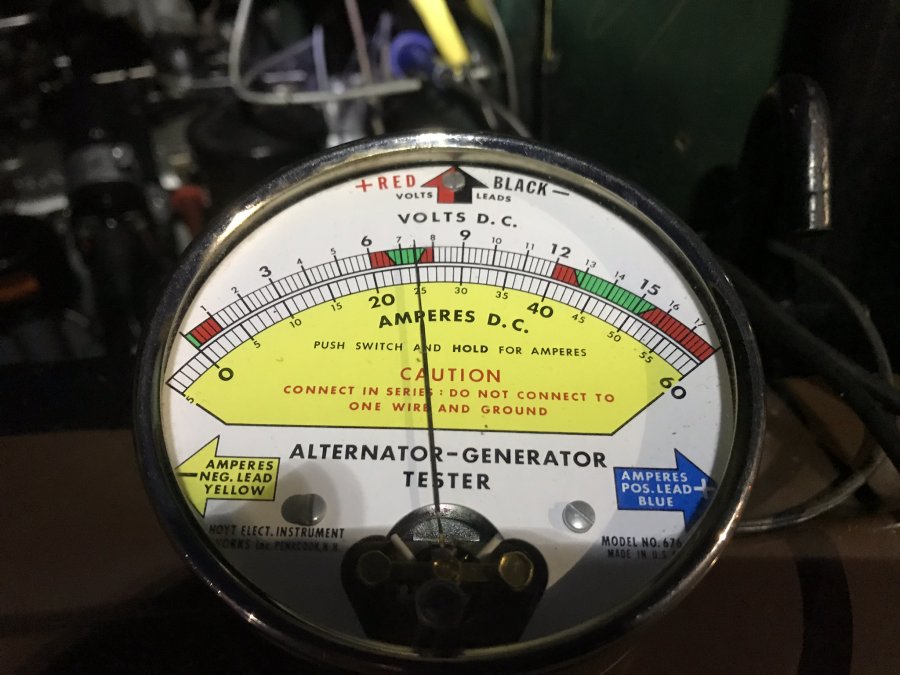-
Posts
1,648 -
Joined
-
Last visited
-
Days Won
19
Content Type
Links Directory
Profiles
Articles
Forums
Downloads
Store
Gallery
Blogs
Events
Everything posted by John-T-53
-
Ah....good to hear. I will check online.... That "figure 8" spring clip...that's the part in the door that the arm slides through?
-
I need one of these for the passenger side... door is dented where it has opened into the rear edge of the front fender as a result of said piece missing.
-
That torque converter looks big in the pictures, and heavy.... What's the new manual trans?
- 699 replies
-
Does the Route Van live in MN? I didn't realize how tall those things were....
-
I just noticed that my truck made it into a Gooogle aerial when it was parked in San Francisco recently....
-

Manual throttle cable repair?
John-T-53 replied to Jeff Balazs's topic in Mopar Flathead Truck Forum
I changed the oil in my friends VW golf (?) or whatever 4-dr little hatchback thing she drives. It had a Plastic oil pan for chrissakes!!! Even the drain plug was plastic, twist it 90 degrees and it pops out. I don't see it lasting through a half dozen oil changes by the jamokes at jiffy-lube.... -
I also used ARP studs and nuts and the value of 55 ft-lbs sounds about right, although I would recommend checking with ARP technical. They are pretty helpful when you call... A set of studs should come with a wee packet of ARP thread lubricant, which is good shite!
-
Whenever it's a "call for price" situation that bumps it into default red flag status - hostile seller....
-
I'm out of vacation time...went to Spain instead. Watch the fishtailin'!
-
The grass must still be growing, which means endless mowing and no time for fun. We just had a couple weeks of unusually late storms out here.
-
I didn't see an asking price....
-
A heads up on this sludge in engines that were running in the days of leaded gas. It contains tetraethyl lead deposits and it's usually found in higher concentrations in the "resting places" such as the oil wells for the tappets and in the pan. It never leaves the engine. It'll absorb through your skin if you don't wear gloves. If you blast parts with it on it, it becomes airborne if not contained well. When it goes in the hot tank or jet wash, the solution then becomes contaminated. Pay attention to anything that comes into contact - tools, rags, clothing, etc and clean or dispose of properly. It's easy to unknowingly bring it into your house where others might be exposed. Helping a friend at his machine shop over the years, cleaning many old engines, made us realize that we have to be careful given the amount of times that we're exposed to this ****...
-
I believe that one essential piece of equipment needed is a "growler". It checks the armature.
-
Another good brand of paint worth mentioning is XO Rust. I think this is usually available at True Value stores. The running board support on the left was painted with their red oxide primer years before the whole frame was stripped and painted. It was over rust too - this was the battery area. When I blasted, sanded, and wire brushed the frame in '12, the red oxide wouldn't budge. So I painted over it. It's an Alkyd like Rust Oleum but better. They have quarts and rattle cans. They even make a sh*t brown color that's a 95% match to my truck!
-
This is my frame - two coats o' POR with either one or two coats of Rust-Oleum industrial flat black on top. You can see some minor runs on the outside of the rail on the side shot, but this is the only time they're noticed....
-
The thing with powder coating I've noticed is it's inability to get into the tight and hidden spots. Like what happened to NiftyFifty's trailer, on fabricated assemblies like frames or trailers there will likely be a small gap in the coating where water can enter into the spaces between members. Corrosion starts there and works outward...bubbling up the coating as it moves. With paint, it usually flows into these spaces by capillary action and makes a good seal....most of the time.
-
I'm not sure either. POR is one of the most durable coatings I've used. I brushed two coats on my frame and underside of the cab, then top coated with rust-oleum flat industrial spray enamel when the second coat was almost dry. I also used this system on the wheel wells and they are still looking good as new after driving it regularly for 7 years... The suspension parts just have two coats of bare POR. They are dirty from use but always clean up nicely and aren't compromised by oil or solvents. With any paint you use, the cleaner the substrate, the better your results. When corners are cut or the prep is flubbed, it always seems that the paint or powder coating gets the blame. With proper prep, one could have an awesome point job with most modern paints available today. An alkyd system such as a red oxide shop primer and top coat, or an epoxy primer and urethane top coat would both provide a durable coating. Alkyds usually have good self-leveling capabilities when brushed. I don't mind a couple brush strokes, drips, or sags on a frame either. Benjamin Moore makes some nice alkyds in their "Super Spec" line. Also their "Corotech" line has alkyd shop primer and Alkyd Urethane enamel for a step up. You can add hardeners for increased durability. Even a water based DTM such as rust oleum sierra performance would be good. Eastwood and Bill Hirsch also have some good chassis paint systems that are said to produce excellent results. Some folks even prefer the Hirsch product that's comparable to POR over POR itself. Eastwood also offers an internal frame coating system that is rattle can based but deployed from a nozzle on the end of a long tube. I don't believe that powder coating is necessarily prone to cracks and hiding rust (especially to the point when there's no metal left and only rust!), nor unfit for exterior use. Personally, I wouldn't use it for coating a frame, but for smaller parts, wheels, or bumpers, it would be a great system. Once again, it's all in the prep. If you powder coat a rusty surface, the rust will come back eventually. A key point is, any of the above coatings are light years ahead of what was applied at the factory. Don't forget your mask and gloves.
-
Welcome to the forum. The inlet is the top pipe on the heater core, which connects to the valve at the back of the cylinder head, and should be marked with cast letters "heater" on the head. The outlet pipe is on the bottom, which connects to the nipple on top of the water pump.
-
That intake and exhaust headers look completely custom. Are they touching each other at all (for heat)? Not the redundant vacuum line going to both throttle bodies too....I wonder why that was done. I don't see a fuel filter, must be down below.
-
I never encountered any shims between the springs and axles. Maybe this was an optional thing depending how the axle came out of the forge.
-
This was posted over on the "For C Bodies Only" Forum last year. I learned a lot about coolant starting here: https://www.forcbodiesonly.com/mopar-forum/threads/ethylene-glycol-or-the-new-permanent-anitfreezes-for-our-original-mopars.38985/page-2#post-587387 IAT (Inorganic Acid Technology): This is the green stuff that we are used to running in our old Mopars. It's actually getting difficult to find now. OAT (Organic Acid Technology): Dexcool is an example of this. DO NOT USE in cooling systems which contain copper or brass components. The additives package does not contain corrosion inhibitors which protect copper/brass. DO NOT MIX with IAT or it will form sludge in the cooling system. HOAT (Hybrid Organic Acid Technology): Can mix with IAT or OAT without causing sludging. HOWEVER, it may not provide adequate corrosion protection if mixed. A half-charge of one type of corrosion inhibitor and a half-charge of another type probably will not equal the protection of a full charge of either. Modern Prestone Universal "mixes with any color antifreeze" is a HOAT. If you're going to use it, I recommend you flush and fill ONLY with Prestone. However, my recommendation is Zerex GO-5. Available as pre-mixed from Walmart and as a concentrate from real auto parts stores. GO-5 is a HOAT and is the same stuff that is factory fill in many modern Mopars, even though it's not the same colour. (GO-5 is a pale yellow that is unfortunately hard to see through the side of the reservoir.) It offers corrosion protection for copper/brass. I converted my '94 Cummins to this. When the coolant in my Chryslers is due to be changed, I will probably convert them over to it also. EDIT: A tech note I found on G-05. Couldn't find anything comparable for Prestone. http://www.consulab.com/files/zerexg05TechBulletin.pdf
-
My radiator support to frame mount was metal to metal as well.
-
Left to right: Voltage regulator (with contact point bracket removed), Current regulator, & cutout relay (circuit breaker).
-
You should have more like 7.5 V. The first photo below shows the voltage range in the green (upper scale). You can adjust the output by setting the contact point gap and bending spring tabs. I wonder if a low battery fried something when you started it up? The second photo is the current reading (Lower scale) with meter connected in series. Readings are always taken with a load on the battery, in this case with the headlights on and heater motor full blast. The factory shop manual gives good instructions on how to service the regulator, I followed them to service mine after about ten years of use - now it's working good again. The points erode and transfer metal over time which leads to decreased performance. All you need to do is file the points and reset the gaps and springs. It's a little tedious but it works. Note: I used small drill bits that were in the range of the specified point gap instead of pin-type gauges. And, the cover must be on while taking readings!
-
This is the bit about polarizing. This is the thing that Merle suggested although I didn't know it would move the needle on the meter...





.jpeg.45788eafb6199d6c0b1a653850ba16a6.jpeg)


